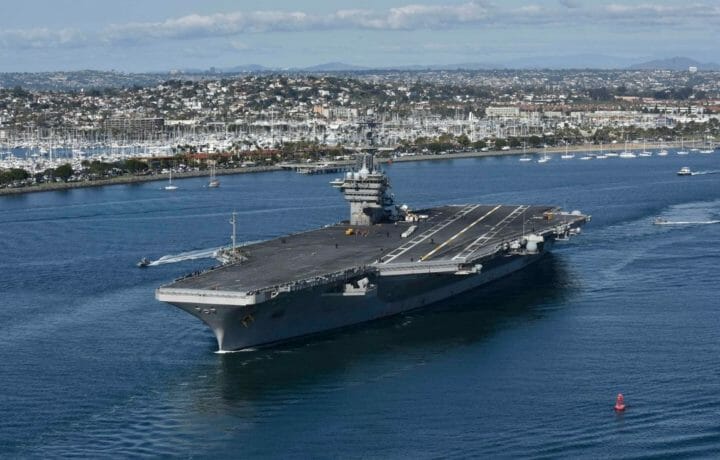Just over a year ago the U.S. Navy’s USS Theodore Roosevelt (CVN-71) returned to duty following an outbreak of the novel coronavirus among the crew. The warship had been sidelined in port in Guam while the crew was treated and the nuclear powered Nimitz-class aircraft carrier was cleaned and sanitized. Of the total 4,800 sailors and marines serving on board the carrier, 1,273 had contracted the coronavirus, and one died. The incident also led to the removal of command of Capt. Brett Crozier, who also had contracted COVID-19.
Now after her most recent deployments, the warship that is named in honor of the 26th president of the United States and saw her first action during Operation Desert Storm in 1991, is changing homeports from San Diego, CA, to Bremerton, WA. CVN-71 will undergo a long overdue dry-dock maintenance period following her back-to-back deployments.
Theodore Roosevelt and USS Dwight D. Eisenhower (CVN-69) had each deployed without a significant maintenance period – called a “Double Pump Deployment” – as the U.S. Navy has struggled to maintain ready carrier strike groups following two decades of the Global War on Terror (GWOT), which required surge deployments to the Middle East.
CVN-69, which is currently deployed to the United States 5th Fleet, is now headed back to Norfolk, Virginia for her own expected maintenance period.
Because of the back-to-back deployments, the crew of Theodore Roosevelt was quarantined in November and left San Diego on Dec. 7, and were away from their families for both the Thanksgiving and December holidays.
Docking Planned Incremental Availability
According to the United States Pacific Fleet, the approximately 3,000 sailors and their families will relocate to Bremerton in July, while the aircraft carrier – the fourth of the Nimitz-class – will enter the Puget Sound Naval Shipyard for a docking planned incremental availability (DPIA) that is set to begin later this year. The shipyard has the only dry dock on the west coast large enough to handle Nimitz-class carriers.
The last DPIA concluded in December 2018.
This DPIA will be a little more significant and the ship will spend approximately 16 to 18 months at the maintenance yard, during which the ship will undergo necessary repairs, but the vessel will also receive modifications to allow her to operate the Lockheed Martin F-35C Lightning II.
“The DPIA is scheduled to commence this September and will include a system retrofit to accommodate the F-35C Lightning II mission capabilities, as well as upgrades to the ship self-defense system (SSDS), the Consolidated Afloat Networks and Enterprise Services (CANES) network, and the Mk 38 25mm machine gun, as well as refurbishment and preservation of the ship’s hull, rudder, propulsion shaft, anchor, and 25 berthing spaces,” the Pacific Fleet said in a statement.
USS Theodore Roosevelt will be the latest of the three carriers based in San Diego to field the F-35C, the Carrier Variant (CV) of the Lightning II. USS Carl Vinson (CVN-71) had successfully completed a series of F-35C certifications last year, and is on track for the first-ever carrier deployment of the jets.
In the coming months, USS Abraham Lincoln (CVN-72) will also deploy the first United States Marine Corp F-35Cs. Marine Fighter Attack Squadron 314, known as the “Black Knights,” based at Marine Corps Air Station Miramar, became the first Marine F-35C squadron to achieve on July 1.
To accommodate the F-35C, the Nimitz-class carriers need to have stronger deflectors installed on the flight decks to handle the jet blast from the combat aircraft’s single engine, while interior spaces on the ships have had to be refurbished to accommodate F-35 missions.




